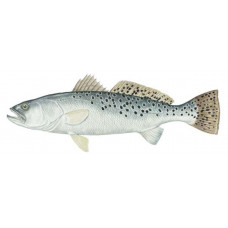Latin name
Cynoscion nebulosus
Other names
Trout, speckled trout, speck, spotted weakfish, spotted squeteague, gator trout, salmon trout, winter trout, black trout; Spanish: corvinata pintada.
Identification
The spotted seatrout has an elongated body with a more regular and straight tail fin with a black edge than the sandy or silver seatrout. The dorsal coloration is dark gray or green, with a sky-blue hue that changes to silvery white. The dorsal fins are gray-green, and the back, tail, and dorsal fins are decorated with numerous round black spots. The lower jaw protrudes beyond the upper jaw, which has one or two prominent fangs. The first dorsal fin has one spike and 24-27 soft rays, and the anal fin has two spikes and 10-11 soft rays. The lower end of the first gill arch has eight or nine short, bristly gill rakes. There are no barbs, and the inside of the mouth is orange. Very young fish have a broad, dark lateral stripe. The presence of spots on the fins makes it possible to distinguish the spotted seatrout from other seatrout.
Distribution
The spotted seatrout is found along the Atlantic and Gulf coasts. They are most abundant along the coast of Georgia, Florida, Alabama, Mississippi, eastern Louisiana, and Texas, but occur as far north as Tampico, Mexico. In late spring they may enter as far north as Long Island, New York, but are more prominent in the mid-Atlantic in the Carolina's, Virginia, and Maryland.
Habitat
Spotted seatrout, a coastal dweller, inhabits shallow bays, estuaries, bays, canals, and beaches of the Gulf Coast. It prefers coastal sandy and grassy bottoms, and may even frequent salt marshes and tidal pools of high salinity. It also lives around oil rigs, usually within 10 miles of shore. Ideal water temperatures range from 58° to 81 °F. Cold water is deadly to the spotted chintz seatrout, with some individuals moving into slow moving or calm deep water in cold weather, most individuals remaining in their normal habitat but may die from low temperatures.
Size
Adult spotted seatrout typically range from 12 to 24 inches and weigh an average of 4 pounds, can reach 48 inches and weigh up to 16 pounds. A record-breaking specimen weighing 17 pounds, 7 ounces were caught in Fort Pierce, Florida, in 1995. They can live up to 10 years. Three-year-old fish in Alabama are usually 12-13 inches long, and four-year-olds are 14-15 inches. Anglers typically catch spotted sieve seatrout weighing between 1 and 3 pounds. Fish over 7 pounds are considered large, and 10-pound individuals are definitely trophies.
Life history and Behavior
Water temperature and salinity levels are thought to be more important for spawning than the specific location because newly hatched fry do not survive in low salinity and low-temperature conditions. Optimal spawning conditions exist when water salinity is between 20 and 34 parts per thousand and temperature reaches 70°-90 °F.
Food and feeding habits
The spotted seatrout is a predator that feeds mainly on shrimp and small fish. When shrimp are scarce, they often consume mullet, menhaden, and silverside fish. Larger specimens feed mainly on fish. Young specimens feed on grass shrimp and copepods.
Reproduction
Spawning takes place at night in coastal bays, bays and lagoons, near passes and around barrier islands from March to November. A female can lay up to 10 million eggs. The eggs hatch within 20 hours and are carried into estuaries by winds and currents. Spotted cutthroat trout are schooling fish and are not considered migratory, as they rarely move more than 30 miles, although they do go to deeper waters or deep holes to avoid low temperatures. Juveniles spend 2 to 4 years in shallow, grassy areas and then tend to move into coastal passages and along beaches.
| Classification | |
| Phylum | Chordata |
| Class | Actinopterygii |
| Squad | Acanthuriformes |
| Family | Sciaenidae |
| Genus | Cynoscion |
| Species | C. nebulosus |
| Features | |
| Conservation status | Least Concern |
| Habitat | Pelagic |
| Life span, years | No information |
| Maximum body weight, kg | 7.9 |
| Maximum length, cm | 122 |
| Sailing speed, m/s | No information |
| Threat to people | Edible |
| Way of eating | Predator |


